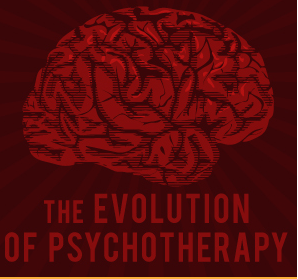Learn about the evolution of psychotherapy, past methods of addressing mental illness and future development. As you can see there have been many approaches to treating disorders!

Image source: Best Counseling Degrees
The Evolution of Psychotherapy
It all began with…
– A Hole in the Head: The earliest form of dealing with the mentally ill was TREPANATION
– Neolithic period to early 20th Century: Since insanity was “caused” by demons lurking inside the skull, boring a hole in the patient’s head could create a door through which the demons could escape. And just like that – out goes the crazy.
– Ancient Greeks: had their own early cures for mental illness
– bathing: early for depression
– bloodletting: for psychosis
– FACT: Around 400 B.C.: Hysteria Therapy: Blame Greek physician Hippocrates. The root cause, according to him, was a wandering womb. His cures involved finding a way to “calm down” the uterus. Plato believed that the only sure-fire way to solve the problem was to get married and have babies.
– Middle Ages: A bit less humane treatment
– torture: for demonic possession
Meanwhile, until Freud and his school of talk therapy developed, here are EIGHT other odd Cures actually used to cure Mental Illness in the 19th and 20th Centuries:
– 1628: Dr. Daniel Oxenbridge a London physician, when trying to cure the young wife of a clothier. First he gave her an enema, and then he bled her arms, her feet, and her forehead. After that, “once every three or four days, I either bled her or vomited her strongly.” He then shaved off all the hair on her head to which he “applied the warm lungs of lambs, sheep and young whelps…”
– 1774: Mesmerism: Austrian physician Franz Mesmer believed the gravity of the moon affected the body’s fluids in much the same way it caused ocean tides, and that some diseases accordingly waxed and waned with the phases of the moon. Mesmer’s solution: placing magnets on certain areas of a patient’s body to counteract the disruptive influence of the moon’s gravity and restore the normal flow of bodily fluids. Today, he’s considered the father of modern hypnosis because of his inadvertent discovery of the power of suggestion, and his name lives on in the English word “mesmerize.”
– Around the turn of the 19th century, Phrenology: German physician Franz Gall developed phrenology, a practice based on the idea that people’s personalities are depicted in the bumps and depressions of their skulls.
– 1811: Rotational Therapy: Joseph Cox invented and Charles Darwin’s grandfather Erasmus Darwin, practiced a spinning couch treatment. The idea was that spinning would reduce brain congestion and, in turn cure mental illness.
– Early 1820s: Hydrotherapy: Developed by Vinzenz Priessnitz. Hyperactive patients got warm, tiring baths, while lethargic patients received stimulating sprays. One treatment involved mummifying the patient in towels soaked in ice-cold water. Another required the patient to remain continuously submerged in a bath for hours even days.
– 1853: Psychotherapeia is a term first used by Walter Cooper Dendy
– 1900: Psychotherapy , as we’ve come to know it, is developed by Austrian Sigmund Freud. It becomes a school called psychoanalysis.
– And Freud begat: Alfred Adler and Carl Jung (both of whom eventually disagreed with some of Freud’s theories and started branches of psychology of their own.
– 1927: Insulin Coma Therapy: Viennese physician Manfred Sakel in 1927 accidentally gave one of his diabetic patients an insulin overdose, and it sent her into a coma. The woman, a drug addict, woke up and declared her morphine craving gone. Began in the 1930s. 1934: Seizure therapy. Hungarian pathologist Ladislas von Meduna reasoned that giving schizophrenics seizures would make them calmer. Thus was born electroconvulsive therapy.
– FACT: In order to do this von Meduna tested numerous seizure-inducing drugs (including strychnine, caffeine, and absinthe) before settling on metrazol, a chemical that stimulates the circulatory and respiratory systems.
– 1930s: Lobotomy: The brainchild of Egas Moniz, a Portuguese doctor. Moniz believed that mental illness was caused by problems in the neurons of the frontal lobe, the part of the brain just behind the forehead. He believed the technique could cure insanity while leaving the rest of the patient’s mental function relatively normal.
– FACT: Moniz was awarded the Nobel Prize in 1949.
– FACT: Dr. Walter Freeman took to traveling the country in his “lobotomobile,” performing the technique on everyone from catatonic schizophrenics to disaffected housewives. His road-ready procedure involved inserting a small ice pick into the brain through the eye socket and wiggling it around a bit.
– 3,459: number of lobotomies Freeman claimed to have performed.
– 2,500: of those were done using ice picks.
– As the number of lobotomies increased, a major problem became apparent. The patients weren’t just calm; they were virtual zombies. The treatment soon fell out of favor.
– 50,000: number of lobotomies performed in U.S. between 1949 and 1952.
– By the late 1960s: there were over 60 different types of psychotherapies, ranging from psychodrama (using drama techniques) to guided imagery (using mental pictures and stories).
Famous people who were lobotomized
– Rosemary Kennedy, sister of JFK Frances Farmer – actress
– Naomi Ginsberg – mother of poet Allen Ginsberg
– Rose Williams – sister of playwright Tennessee Williams
The Swinging Sixties
– Esalen Institute in Big Sur, Ca. opens, a new humanistic movement begins:
– Gestalt Therapy
– Encounter group therapy
– 1 million people have gone to this mystical retreat, including: Joan Baez, Beatle George Harrison, physicians Dean Ornish and Andrew Weil, writers Henry Miller and Aldous Huxley.
– FACT: The mega hit Bob, Carol, Ted and Alice satirized wife swapping therapy.
FIVE GREAT MOVIES Involving Psychotherapy
– David and Lisa — A film from the 1960’s shows good examples of the benefit of psychotherapy and the difficulties for the severely ill.
– Don Juan DeMarco (1995) — Johnny Depp plays a man who becomes a psychiatric inpatient treated with only psychotherapy by his psychiatrist (Marlin Brando), who is increasingly pressured by hospital medical superiors to prescribe drug treatment.
– Equus – (1977) Stars Richard Burton as a psychiatrist trying to understand a young man who blinded horses during a psychotic episode.
– Frances (1983)– About Frances Farmer–a movie star who ended up having a lobotomy.
– Three Faces Of Eve – (1957) – A doctor treats a woman suffering from Dissociative Identity Disorder.
The Future of Psychotherapy
– Therapy apps for smartphones: may soon make psychological help accessible anytime, anywhere, whether in the grocery store line, on the bus or just before a work presentation.
– 2011: e-psychiatry becomes more and more acceptable using Skype and online therapy and videoconferencing. Telepsychiatry has been around since the 1990s. cognitive bias modification, or C.B.M.: Many who struggle with anxiety fixate subconsciously on hostile faces in a crowd of people with mostly relaxed expressions, as if they see only the bad apples in a bushel of mostly good ones. Modifying that bias can short-circuiting anxiety.
– Video Game Therapy: studies indicate that gamers who take control of their dreams experience fewer nightmares, amongst other unexpected events. Related to that…
– Avatar Therapy: This innovation in psychotherapy combines artificial intelligence and distance technology with elements of traditional psychotherapeutic techniques.
– SciFi, or reality?: 20 years from now mind-machine interfaces will be available, through creating a brain implant similar to the way cochlear implants improve hearing today.
Sources
– http://www.neatorama.com/2007/06/12/10-mind-boggling-psychiatric-treatments/
– http://psychcentral.com/lib/history-of-psychotherapy/000115
– http://thelimbicregion.tripod.com/id38.htm
– http://laingsociety.org/cetera/timeline.htm
– http://answers.yahoo.com/question/index?qid=20080826174337AAjiAnF
– http://fritzperls.com/biography/
– http://www.npr.org/templates/story/story.php?storyId=5014565
– http://www.wisegeek.com/what-is-an-encounter-group.htm
– http://www.isps-us.org/isps-us_bibliographies_movies.html
– http://www.nytimes.com/2011/09/25/fashion/therapists-are-seeing-patients-online.html?pagewanted=all&_r=0
– http://www.nytimes.com/2012/02/14/health/feeling-anxious-soon-there-will-be-an-app-for-that.html?_r=2&hpw&
– http://www.sfgate.com/living/article/Esalen-Institute-turns-50-this-year-3906021.php
– http://blogs.voanews.com/digital-frontiers/2012/10/02/video-games-the-future-of-psychotherapy/
– http://thefutureofinnovation.org/contributions/view/893/the_future_of_innovation_the_use_of_avatars_in_psychotherapy
– http://www.positivefuturist.com/archive/02.html
Want to know your astrology placements? You can generate your astrology chart here with our free birth chart generator tool.
- American Presidents Ranked By Zodiac Sign - January 20, 2025
- ESTP and ESFP in love: 6 Dynamics of Their Relationship - September 4, 2024
- ISFP and ISTP in love: 5 Dynamics of their Relationship. - August 28, 2024





